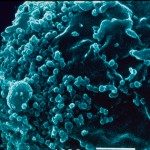Link to Pubmed [PMID] – 8918929
Virology 1996 Nov;225(2):413-8
Infection with HIV-1 results in a disruption of the thymic microenvironment and the presence of HIV-1 in thymic epithelial cells has been demonstrated in vivo. In the present study, we examined the susceptibility of a highly enriched culture of thymic epithelial cells (TEC) to infection in vitro by HIV-1 laboratory strains and primary isolates. Replication in TEC is shown to depend on the virus and on the expression of CD4 molecules that are found to be expressed at a low density on the plasma membrane. Our results are consistent with infection of TEC controlled by the efficiency of the interactions between the envelope glycoprotein of the virus and the cell surface molecules. As a consequence, certain HIV-1 viruses induce a productive and persistent infection in TEC without damaging the cells. Altogether these results support the idea that TEC may act as a reservoir for HIV-1 in the thymus but are probably destroyed by an indirect mechanism involving infection of thymocytes.

